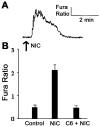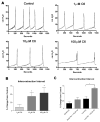Expression of functional nicotinic acetylcholine receptors in rat urinary bladder epithelial cells
- PMID: 16144967
- PMCID: PMC2760261
- DOI: 10.1152/ajprenal.00098.2005
Expression of functional nicotinic acetylcholine receptors in rat urinary bladder epithelial cells
Abstract
Although nicotinic acetylcholine receptors in both the central and peripheral nervous systems play a prominent role in the control of urinary bladder function, little is known regarding expression or function of nicotinic receptors in the bladder epithelium, or urothelium. Nicotinic receptors have been described in epithelial cells lining the upper gastrointestinal tract, respiratory tract, and the skin. Thus the present study examined the expression and functionality of nicotinic receptors in the urothelium, as well as the effects of stimulation of nicotinic receptors on the micturition reflex. mRNA for the alpha3, alpha5, alpha7, beta3, and beta4 nicotinic subunits was identified in rat urothelial cells using RT-PCR. Western blotting also confirmed urothelial expression of the alpha3- and alpha7-subunits. Application of nicotine (50 nM) to cultured rat urothelial cells elicited an increase in intracellular Ca2+ concentration, indicating that at least some of the subunits form functional channels. These effects were blocked by the application of the nicotinic antagonist hexamethonium. During in vivo bladder cystometrograms in urethane-anesthetized rats, intravesical administration of nicotine, choline, or the antagonists methyllycaconitine citrate and hexamethonium elicited changes in voiding parameters. Intravesical nicotine (50 nM, 1 microM) increased the intercontraction interval. Intravesical choline (1-100 microM) also affected bladder reflexes similarly, suggesting that alpha7 nicotinic receptors mediate this effect. Intravesical administration of hexamethonium (1-100 microM) potentiated the nicotine-induced changes in bladder reflexes. Methyllycaconitine citrate, a specific alpha7-receptor antagonist, prevented nicotine-, choline-, and hexamethonium-induced bladder inhibition. These results are the first indication that stimulation of nonneuronal nicotinic receptors in the bladder can affect micturition.
Figures










Similar articles
-
Differential expression and function of nicotinic acetylcholine receptors in the urinary bladder epithelium of the rat.J Physiol. 2012 Mar 15;590(6):1465-80. doi: 10.1113/jphysiol.2011.226860. Epub 2012 Jan 16. J Physiol. 2012. PMID: 22250215 Free PMC article.
-
Roles of peripheral and central nicotinic receptors in the micturition reflex in rats.J Urol. 2006 Jul;176(1):374-9. doi: 10.1016/S0022-5347(06)00581-7. J Urol. 2006. PMID: 16753446
-
Effects of nicotinic receptor agonists on bladder afferent nerve activity in an in vitro bladder-pelvic nerve preparation.Brain Res. 2016 Apr 15;1637:91-101. doi: 10.1016/j.brainres.2016.02.009. Epub 2016 Feb 11. Brain Res. 2016. PMID: 26876739 Free PMC article.
-
Influence of urothelial or suburothelial cholinergic receptors on bladder reflexes in chronic spinal cord injured cats.Exp Neurol. 2016 Nov;285(Pt B):147-158. doi: 10.1016/j.expneurol.2016.07.005. Epub 2016 Jul 14. Exp Neurol. 2016. PMID: 27423814 Free PMC article.
-
Pannexin 1 channels mediate the release of ATP into the lumen of the rat urinary bladder.J Physiol. 2015 Apr 15;593(8):1857-71. doi: 10.1113/jphysiol.2014.283119. Epub 2015 Feb 11. J Physiol. 2015. PMID: 25630792 Free PMC article.
Cited by
-
Role of Nicotinic Acetylcholine Receptor α3 and α7 Subunits in Detrusor Overactivity Induced by Partial Bladder Outlet Obstruction in Rats.Int Neurourol J. 2015 Mar;19(1):12-8. doi: 10.5213/inj.2015.19.1.12. Epub 2015 Mar 26. Int Neurourol J. 2015. PMID: 25833476 Free PMC article.
-
Potential therapeutic uses of mecamylamine and its stereoisomers.Pharmacol Biochem Behav. 2013 Jul;108:28-43. doi: 10.1016/j.pbb.2013.04.005. Epub 2013 Apr 18. Pharmacol Biochem Behav. 2013. PMID: 23603417 Free PMC article. Review.
-
TRPV4 receptor as a functional sensory molecule in bladder urothelium: Stretch-independent, tissue-specific actions and pathological implications.FASEB J. 2020 Jan;34(1):263-286. doi: 10.1096/fj.201900961RR. Epub 2019 Nov 21. FASEB J. 2020. PMID: 31914645 Free PMC article.
-
Increased expression of neuregulin 1 in the urothelium of rat bladder with partial bladder outlet obstruction.BMC Urol. 2017 Dec 8;17(1):115. doi: 10.1186/s12894-017-0307-2. BMC Urol. 2017. PMID: 29221474 Free PMC article.
-
Receptor activated bladder and spinal ATP release in neurally intact and chronic spinal cord injured rats.Neurochem Int. 2007 Jan;50(2):345-50. doi: 10.1016/j.neuint.2006.09.002. Epub 2006 Oct 25. Neurochem Int. 2007. PMID: 17067723 Free PMC article.
References
-
- Andersson KE. Bladder activation: afferent mechanisms. Urology. 2002;59:43–50. - PubMed
-
- Andersson KE, Yoshida M. Antimuscarinics and the overactive detrusor–which is the main mechanism of action? Eur Urol. 2003;43:1–5. - PubMed
-
- Beckel JM, Birder LA, Kiss S, Kanai AJ, Lee SJ, Yoshiyama M, de Groat WC. Expression of nicotinic acetylcholine receptors in the rat urothlieum (Abstract) Soc Neurosci Abstr. 2002;32:538.510.
-
- Birder LA. Involvement of the urinary bladder urothelium in signaling in the lower urinary tract. Proc West Pharmacol Soc. 2001;44:85–86. - PubMed
-
- Birder LA, Barrick SR, Roppolo JR, Kanai AJ, de Groat WC, Kiss S, Buffington CA. Feline interstitial cystitis results in mechanical hypersensitivity and altered ATP release from bladder urothelium. Am J Physiol Renal Physiol. 2003;285:F423–F429. - PubMed
Publication types
MeSH terms
Substances
Grants and funding
LinkOut - more resources
Full Text Sources
Other Literature Sources
Miscellaneous

